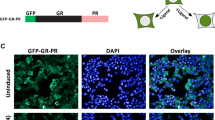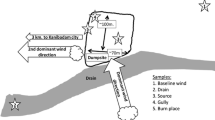Abstract
In order to monitor the (anti)steroid activity of environmental samples, we established stable cell lines expressing luciferase under the control of estrogens, androgens, progestives and glucocorticoids. The breast cancer MCF-7 cells which express the estrogen receptor α (ERα), the glucocorticoid receptor (GR) and the progesterone receptor (PR) were transfected by an estrogen (ERE-βGlob-Luc) or a glucocorticoid/progestin/androgen (MMTV-Luc) regulated luciferase plasmid in order to enable the detection of compounds which bind both ERα, PR and GR (MELN and MMLN cells). Human prostatic cells PC3 were stably transfected by both an androgen receptor gene and the MMTV-luciferase plasmid (PALM cells). These three cellular models were validated as tools to check the estrogenic, progestive, glucocorticoid and androgenic activities using several potential xenohormones and environmental samples. As these environmental samples were fractionated after solid phase extraction to isolate active compounds, we used these cellular models to monitor the different fractions. In the estrogenic model mid-polar fractions of environmental samples were found active while in the androgenic model, the same fractions had antagonist activity.
Similar content being viewed by others
References
Ahel, M., Giger, W. and Schaffner C. (1994). Behaviour of alkylphenol polyethoxylate surfactants in the aquatic environment?II. Occurrence and transformation in rivers. Wat. Res. 28(5), 1143-52.
Balaguer, P., Francois, F., Comunale, F., Fenet, H., Boussioux, A.-M., Pons, M., Nicolas, J.-C. and Casellas, C. (1999). Reporter cell lines to study the activity of xenoestrogens. Sci. Total Environ. 233, 47-56.
Bennett, E.R. and Metcalfe, C.D. (1998). Distribution of alkylphenol compounds in great lakes sediments, United States and Canada. Environ. Toxicol. Chem. 17(7), 1230-5.
Blackburn, M.A. and Waldock, M.J. (1995). Concentrations of alkylphenols in rivers and estuaries in England and Wales. Wat. Res. 29(7), 1623-9.
Cheek, A.O., Vonier, P.M., Oberdorster, E., Burow, B.C. and McLachlan, J.A. (1998). Environmental signalling: a biological context for endocrine disruption. Environ. Health Perspect. 106(1), 5-10.
Desbrow, C., Routledge, E.J., Brighty, G.C., Sumpter, J.P. and Waldock, M. (1998). Identification of estrogenic chemicals in STW effluent. 1. Chemical fractionation and in vitro biological screening. Environ. Sci. Tech. 32, 1549-58.
Gillesby, B.E. and Zacharewski, T. (1998). Exoestrogens: mechanisms of actions and strategies for identification and assessment. Environ. Toxicol. Chem. 17, 3-14.
Harries, J.E., Sheahan, D.A., Jobling, S., Matthiessen, P., Neall, P., Routledge, E.J., Rycroft, R., Sumpter, J.P. and Tylor, T. (1996). A survey of estrogenic activity in United Kingdom inland waters. Environ. Toxicol. Chem. 15(11), 1993-2002.
Harris, C.E., Henttu, P., Parker, M.G. and Sumpter, J.P. (1997). The estrogenic activity of phthalate esters in vitro. Environ. Health Perspect. 105(8), 802-11.
Jausons-Loffreda, N., Balaguer, P., Roux, S., Fuentes, M., Pons, M., Nicolas, J.-C., Gelmini, S. and Pazzagli, M. (1994). Chimeric receptors as a tool for luminescent measurement of biological activities of steroid hormones. J. Biolum. Chemilum. 9, 217-21.
Jobling, S. and Sumpter, J.P. (1993). Detergent components in sewage effluent are weakly estrogenic to fish: an in vitro study using rainbow trout Oncorhynchus mykiss hepatocytes. Aquatic Toxicology 27, 361-72.
Jobling, S., Reynolds, T., White, R., Parker, M.G. and Sumpter, J.P. (1995). A variety of environmentally persistent chemicals, including some phthalate plasticizers, are weakly estrogenic. Environ. Health Perspect. 103(6), 582-7.
Joyeux, A., Balaguer, P., and Nicolas, J.-C. (1997). Engineered cell lines as a tool to monitor biological activity of endocrine hormones. Anal. Biochem. 249, 119-30.
Kelce, W.R. and Wilson, A.M. (1997) Environmental antiandrogens: developmental effects, molecular mechanisms, and clinical implications. J. Mol. Med. 5, 198-207.
Le Bail, J.C., Varnat, F., Nicolas, J.C. and Habrioux, G. (1998). Estrogenic and antiproliferative activities on MCF7 human breast cancer cells by flavonoids. Cancer Letters 130, 209-16.
May, F.E., Johnson, M.D., Wiseman, L.R., Wakeling, A.E., Kastner, P. and Westley, B.R. (1989). Regulation of progesterone receptor mRNA by oestradiol and antiestrogens in breast cancer cell lines. J. Steroid Biochem. 33, 1035-41.
Moore, M., Mustain, M., Daniel, K., Chen, I., Safe, S., Zacharewski, T., Gillesby, B., Joyeux, A. and Balaguer, P. (1997). Antiestrogenic activity of hydroxylated polychlorinated biphenyl congeners identified in human serum. Toxicol. Appl. Pharmacol. 142, 160-8.
Routledge, E.J., Sheahan, D., Desbrow, C., Brighty, C., Waldock, M. and Sumpter, P. (1998). Identification of estrogenic chemicals in STW effluent. 2. In vitro responses in trout and roach. Environ. Sci. Technol. 32(11), 1559-65.
Routledge, E.J. and Sumpter, J.P. (1996). Estrogenic activity of surfactants and some of their degradation products assessed using a recombinant yeast screen. Environ. Toxicol. Chem. 15(3), 241-8.
Soto, A.M., Michaelson, C.L., Prechtl, N.V., Weill, B.C., Sonnenschein, C., Serrano, F.O. and Olea, N. (1999). Assays to measure estrogen and androgen agonists and antagonists. Adv. Exp. Med. Biol. 444, 9-23.
Terouanne, B., Tahiri, B., Georget, G., Belon, C., Poujol, N., Avances, C., Orio, F., Balaguer, P. and Sultan, C. A stable prostatic bioluminescent cell line to investigate androgen and antiandrogen effects. Mol. Cell. Endocrinol. (in press).
Toppari, J., Larsen, J.C., Christiansen, P., Giwercman, A., Grandjean, P., Guillette, L.J., Jegou, B., Jensen, T.K., Jouannet, P., Keiding, N., Leffers, H., McLachlan, J.A., Meyer, O., Muller, J., Rajpert-De Meyts, E., Scheike, T., Sharpe, R., Sumpter, J. and Skakkebaek, N. (1996). Male reproductive health and environmental xenoestrogens. Environ. Health. Perspect. 104, 741-803.
Vinguard, A.M., Loergensen, E.C. and Larsen, J.C. (1999). Rapid and sensible reporter gene assays for detection of antiandrogenic and estrogenic effects of environmental chemicals. Toxicol. Appl. Pharmacol. 150-60.
Wong, C.K., Kelce, W.R., Sar, M. and Wilson, E. (1995). Androgen receptor antagonist versus agonist activities of the fungicide vinclozolin relative to hydroxuflutamide. J. Biol. Chem. 270, 19998-20003.
Author information
Authors and Affiliations
Rights and permissions
About this article
Cite this article
Balaguer, P., Fenet, H., Georget, V. et al. Reporter Cell Lines to Monitor Steroid and Antisteroid Potential of Environmental Samples. Ecotoxicology 9, 105–114 (2000). https://doi.org/10.1023/A:1008980515297
Issue Date:
DOI: https://doi.org/10.1023/A:1008980515297




